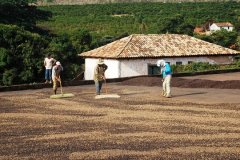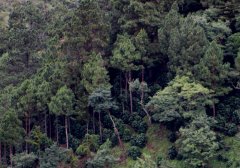How about Salvadoran Himalayan Coffee A brief History of Salvadoran Coffee and Coffee Archives

For professional baristas, please follow the coffee workshop (Wechat official account cafe_style)
A brief history of coffee in El Salvador:
In the mid-19th century, El Salvador became independent from Nicaragua after the disintegration of the Union, and its cash crops were mainly locust blue plants.
It was a crop used to make indigo dye, and it was not until the invention of chemical dyes in the mid-19th century that the land was converted to growing coffee.
Because of the support of the aristocracy and the background of militarized rule, the political situation is relatively stable, and the coffee industry has also led to the development of non-governmental industry.
In the 1880s, it even became the fourth largest coffee producer in the world. The civil war broke out in 1980, which had a great impact on coffee production and trade.
El Salvador flew to the branches to be a Phoenix:
In recent years, native varieties have been retained due to the civil war.
At the same time, it also developed a hybrid bean "Pacamara" with the Japanese Coffee Research Institute.
This new breed combines two Arabica hybrids: Maragojipe and Pacas.
In the international "extraordinary Cup" auction, it only took four years to get through, and won the first to fourth place in the cup test in 2007!
El Salvador Coffee Mini File:
The main method of treatment is washing, and part of it is picking and sunbathing. The main varieties are: Arabica, there are: bourbon, Pacas, Pacamara … Wait.
The production season is from 10m / m to March. It is currently the 15th largest coffee producer in the world.
Altitude classification:
El Salvador still uses altitude classification, which has nothing to do with quality or production and marketing experience.
There are three levels of topography alone.
How to distinguish the elevation grades:
Strictly High Grown (SHG): planted more than 1200 meters above sea level.
Hight Grown (HG): over 900m above sea level.
Central Standard: plant more than 600m above sea level.
Salvadoran coffee features:
El Salvador coffee is full-bodied, full-bodied and sweet, with aromas of dried fruit, citrus, chocolate and caramel.
It is most famous for its sweet and supple acidity, which is very symmetrical and harmonious.
Important Notice :
前街咖啡 FrontStreet Coffee has moved to new addredd:
FrontStreet Coffee Address: 315,Donghua East Road,GuangZhou
Tel:020 38364473
- Prev

How do you drink Salvadoran coffee? Introduction to the characteristic flavor of El Salvador organic coffee and hot spring coffee
For the exchange of professional baristas, please follow the coffee workshop (Wechat official account cafe_style) El El Salvador belongs to the highland terrain and is the smallest country in Central America. Because there are two parallel mountains in the country, the volcanic soil is rich in minerals, and this special geographical environment makes El Salvador suitable for growing coffee. Sal.
- Next

El Coffee COE Manor-extraordinary Cup Champion Manor Santa Rosa Santa Rosa Manor introduction
Exchange of professional baristas follow the Coffee Workshop (Wechat official account cafe_style) Santa Rosa, which just won the Cup of Excellence Cup in El Salvador last month, began its dream of winning the COE championship in the 1/4 century ago. In 1979, the elder Rivera Jorge Raul Rivera was in Chalaten.
Related
- Detailed explanation of Jadeite planting Land in Panamanian Jadeite Manor introduction to the grading system of Jadeite competitive bidding, Red bid, Green bid and Rose Summer
- Story of Coffee planting in Brenka region of Costa Rica Stonehenge Manor anaerobic heavy honey treatment of flavor mouth
- What's on the barrel of Blue Mountain Coffee beans?
- Can American coffee also pull flowers? How to use hot American style to pull out a good-looking pattern?
- Can you make a cold extract with coffee beans? What is the right proportion for cold-extracted coffee formula?
- Indonesian PWN Gold Mandrine Coffee Origin Features Flavor How to Chong? Mandolin coffee is American.
- A brief introduction to the flavor characteristics of Brazilian yellow bourbon coffee beans
- What is the effect of different water quality on the flavor of cold-extracted coffee? What kind of water is best for brewing coffee?
- Why do you think of Rose Summer whenever you mention Panamanian coffee?
- Introduction to the characteristics of authentic blue mountain coffee bean producing areas? What is the CIB Coffee Authority in Jamaica?

